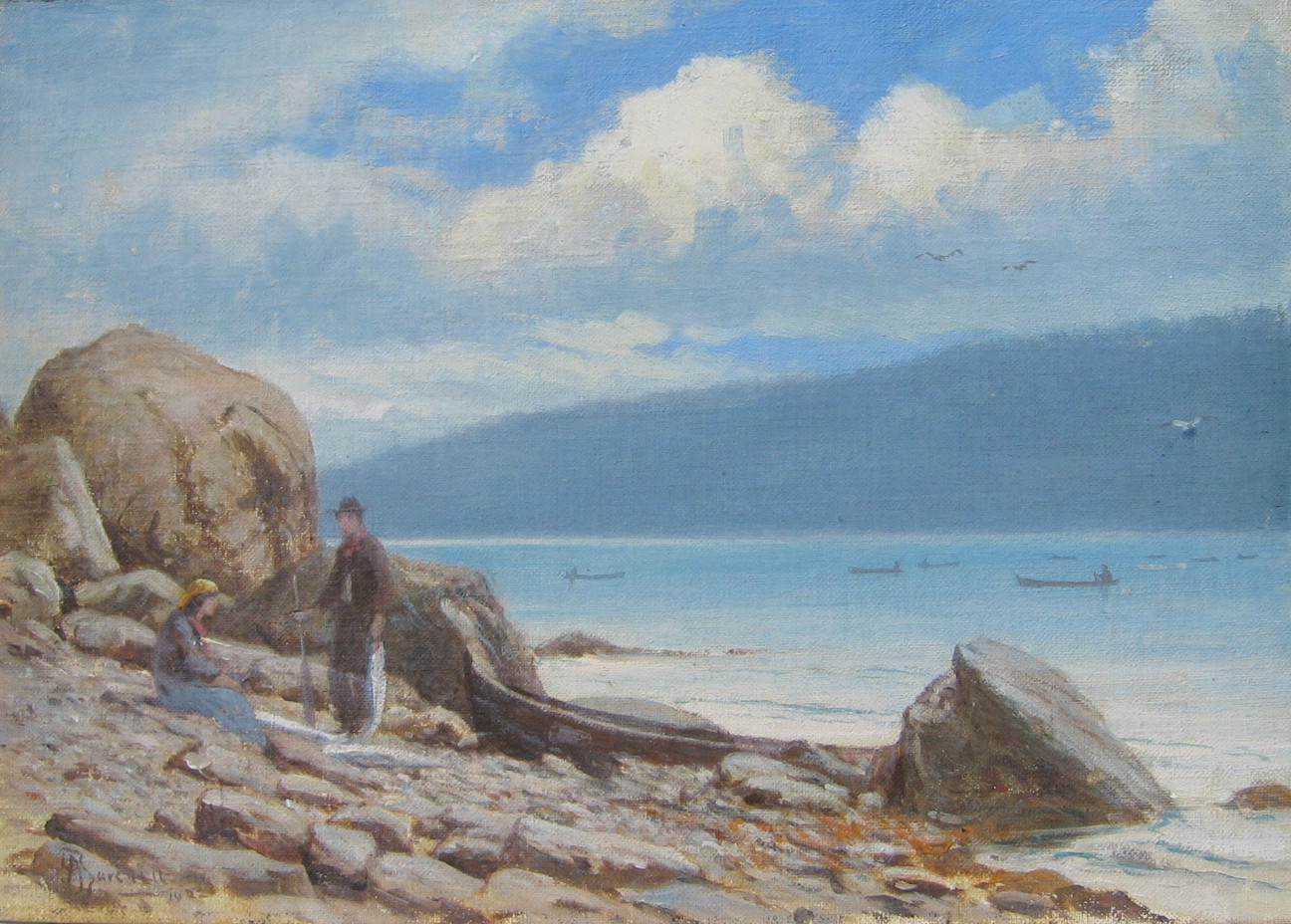Arthur Burchett, 1953-1927
Arthur Burchett was born on the 20th of August 1853 at Highgate, London, England. He was an artist who devoted his life to painting and to portrait photography. He was a student at the Royal Academy of Arts, London, exhibiting in the British Royal Academy from 1875 to 1900, the Dudley Gallery, London, The Royal Society of British Artists, and in Paris as well as other centres. He received medals in various parts of the world for his exhibits in photography. He painted in both oil and watercolor and concentrated mainly on landscapes. Arthur continued to paint, photograph, and teach in Canada. He maintained a studio for some years on College Street in Duncan. He later exhibited his work with the Island Arts and Crafts Society between 1914 and 1920, in 1926 he exhibited work at the Vancouver Exhibition.
Arthur was also a co-founder of the Linked Ring Brotherhood. The Brotherhood was "a means of bringing together those who are interested in the development of the highest form of Art of which Photography is capable. The Linked Ring (also known as "The Brotherhood of the Linked Ring") was a photographic society created to propose and defend that photography was just as much an art as it was a science, motivated to propelling photography further into the fine art world. Members dedicated to the craft looked for new techniques that would cause less knowledgeable to steer away, persuading photographers and enthusiasts to experiment with chemical processes, printing techniques and new styles.
Photography was interpreted in two ways; art photography and science photography. The science of photography requires practice that determines the outcome of the image, whereas the art aspect of photography concerns itself with the aesthetic experience and success of the photograph to the viewer. These differences created a tension in the craft that the Linked Ring sought to change.
The group was founded in May, 1892, by Henry Peach Robinson, former Photographic Society member George Davison, and Henry Van der Weyde. The Brotherhood was "a means of bringing together those who are interested in the development of the highest form of Art of which Photography is capable."Membership of the group was by invitation only; other members included William Smedley-Aston, Walter Benington, Arthur Burchett, Frank Sutcliffe, Frederick H. Evans, Paul Martin, Alvin Langdon Coburn, Frederick Hollyer, J. B. B. Wellington, Richard Keene, James Craig Annan, Alfred Horsley Hinton, Lydell Sawyer, Alfred Maskell and, later, Americans Alfred Stieglitz, Rudolf Eickemeyer, Jr., and Clarence H. White. Although works by female photographers such as those by Zaida Ben-Yusuf were exhibited at the annual shows during the 1890s, it was not until 1900 that Gertrude Käsebier became one of the first elected female members of the Ring.
In November 1893, Robinson created the Photographic Salon, an annual exhibit event in England whose aim was to "exhibit (images) that are description of pictorial photography in which there is distinct evidence of personal feeling and execution." As a result, interest grew in processes such as gum bi-chromate, oil pigment and transfer, and supported the trend in producing images not for reproduction, but works of high value, as well as creating interest in surface texture, papers, and color of print.
In 1896 they began publishing The Linked Ring Papers, which were circulated annually to members until 1909 to promote and discuss the aesthetics and practice of Pictorialism. The Photo-Secession was founded by photographer Alfred Stieglitz in 1902. Stieglitz wanted to show that photography had artistic expression similar to that of painting and sculpture, emphasizing further the craftsmanship abilities of photographers. Photo-Secession members were also called American Links, and displayed works in the Little Galleries of the Photo-Secession at Fifth Avenue, New York City. Members include Mary Devens, Frank Eugene, Gertrude Käsebier, William B. Dyer, Eva Watson-Schütze, Edward Steichen, Edmund Stirling, and Clarence H. White.
Pictorialist James Craig Annan, born into a household at the forefront of photography technology. In 1866 his father created a four foot print of an eleven foot painting with the new process of carbon printing. This became Annan’s primary influence to become a skilled photographer himself. At a young age, learned the process of photogravure in Vienna on a trip with his father. This process allowed Annan to work like an etcher, sharpening, shading, or blurring areas of the picture, describing this process as “a long drawn out pleasure.”
Frederick H. Evans was responsible for leading the Linked Ring's photography magazines, writing publications for the newspaper, and installations at Photo Salon. Regarded as being one of the most gifted and sensitive of "the Links" Evans is known for his images of architecture, specifically cathedrals. He is known to have spent weeks living in the cathedrals he photographed waiting for ideal lighting conditions to reveal the poetry in his subjects. Frank S. Sutcliffe was most well known for his image “Water Rats”, exemplary of being one of the first images showing depth of field accomplished in camera.
The Brotherhood represented themselves with a logo of three interlinked rings, which were meant in part to represent the Masonic beliefs of Good, True, and Beautiful.
Arthur died at the age of 73 on 2 July 1927 in Duncan, British Columbia, Canada. He is buried at St. Mary’s Cemetery, Somenos, British Columbia.
Sources
Other Links
An example of his oil paintings "In the Park" (1904) is in the collection of the Art Gallery of Greater Victoria (Accession Number: 1973.267.001) and other works are retained by the family.
Victoria BC Art Gallery
Westbridge Auctions
Photoseed
Portrait of Arthur Burchett, artist unknown, ca 1890






